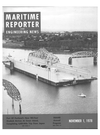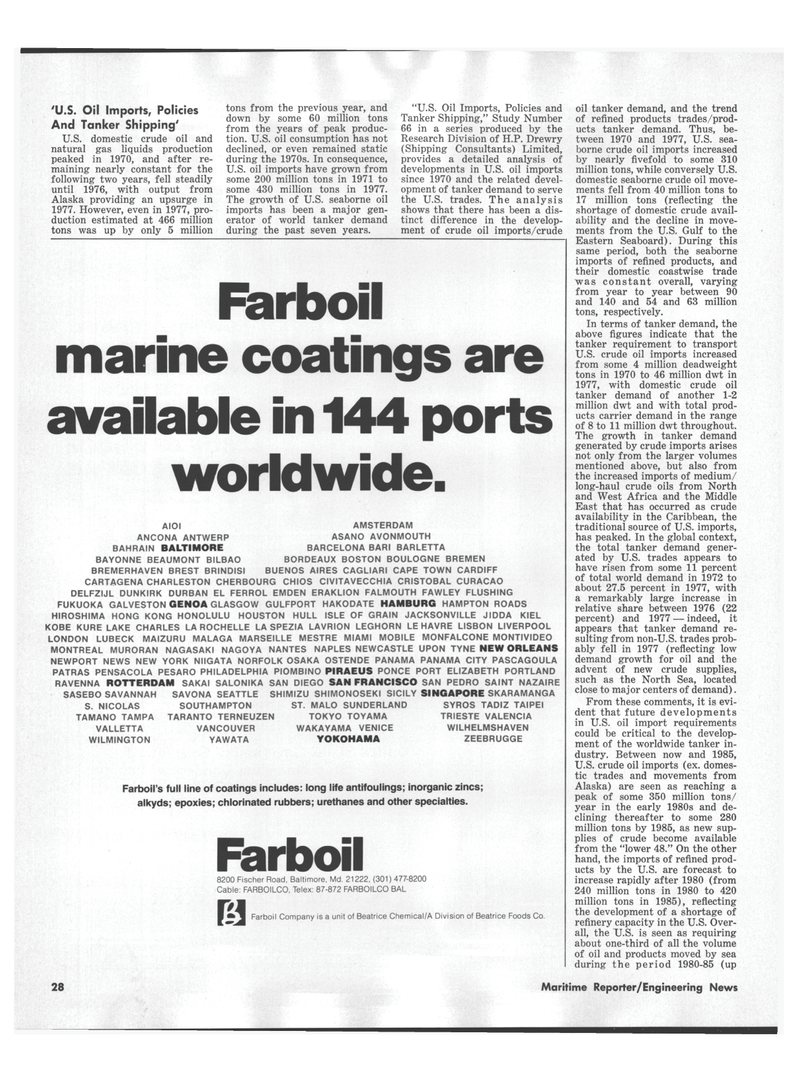
Page 30: of Maritime Reporter Magazine (November 1978)
Read this page in Pdf, Flash or Html5 edition of November 1978 Maritime Reporter Magazine
'U.S. Oil Imports, Policies
And Tanker Shipping'
U.S. domestic crude oil and natural gas liquids production peaked in 1970, and after re- maining nearly constant for the following two years, fell steadily until 1976, with output from
Alaska providing an upsurge in 1977. However, even in 1977, pro- duction estimated at 466 million tons was up by only 5 million tons from the previous year, and down by some 60 million tons from the years of peak produc- tion. U.S. oil consumption has not declined, or even remained static during the 1970s. In consequence,
U.S. oil imports have grown from some 200 million tons in 1971 to some 430 million tons in 1977.
The growth of U.S. seaborne oil imports has been a major gen- erator of world tanker demand during the past seven years. "U.S. Oil Imports, Policies and
Tanker Shipping," Study Number 66 in a series produced by the
Research Division of H.P. Drewry (Shipping Consultants) Limited, provides a detailed analysis of developments in U.S. oil imports since 1970 and the related devel- opment of tanker demand to serve the U.S. trades. The analysis shows that there has been a dis- tinct difference in the develop- ment of crude oil imports/crude oil tanker demand, and the trend of refined products trades/prod- ucts tanker demand. Thus, be- tween 1970 and 1977, U.S. sea- borne crude oil imports increased by nearly fivefold to some 310 million tons, while conversely U.S. domestic seaborne crude oil move- ments fell from 40 million tons to 17 million tons (reflecting the shortage of domestic crude avail- ability and the decline in move- ments from the U.S. Gulf to the
Eastern Seaboard). During this same period, both the seaborne imports of refined products, and their domestic coastwise trade was constant overall, varying from year to year between 90 and 140 and 54 and 63 million tons, respectively.
In terms of tanker demand, the above figures indicate that the tanker requirement to transport
U.S. crude oil imports increased from some 4 million deadweight tons in 1970 to 46 million dwt in 1977, with domestic crude oil tanker demand of another 1-2 million dwt and with total prod- ucts carrier demand in the range of 8 to 11 million dwt throughout.
The growth in tanker demand generated by crude imports arises not only from the larger volumes mentioned above, but also from the increased imports of medium/ long-haul crude oils from North and West Africa and the Middle
East that has occurred as crude availability in the Caribbean, the traditional source of U.S. imports, has peaked. In the global context, the total tanker demand gener- ated by U.S. trades appears to have risen from some 11 percent of total world demand in 1972 to about 27.5 percent in 1977, with a remarkably large increase in relative share between 1976 (22 percent) and 1977 — indeed, it appears that tanker demand re- sulting from non-U.S. trades prob- ably fell in 1977 (reflecting low demand growth for oil and the advent of new crude supplies, such as the North Sea, located close to major centers of demand).
From these comments, it is evi- dent that future developments in U.S. oil import requirements could be critical to the develop- ment of the worldwide tanker in- dustry. Between now and 1985,
U.S. crude oil imports (ex. domes- tic trades and movements from
Alaska) are seen as reaching a peak of some 350 million tons/ year in the early 1980s and de- clining thereafter to some 280 million tons by 1985, as new sup- plies of crude become available from the "lower 48." On the other hand, the imports of refined prod- ucts by the U.S. are forecast to increase rapidly after 1980 (from 240 million tons in 1980 to 420 million tons in 1985), reflecting the development of a shortage of refinery capacity in the U.S. Over- all, the U.S. is seen as requiring about one-third of all the volume of oil and products moved by sea during the period 1980-85 (up
Farboil marine coatings are available in 144 ports worldwide.
AIOI AMSTERDAM
ANCONA ANTWERP ASANO AVONMOUTH
BAHRAIN BALTIMORE BARCELONA BAR! BARLETTA
BAYONNE BEAUMONT BILBAO BORDEAUX BOSTON BOULOGNE BREMEN
BREMERHAVEN BREST BRINDISI BUENOS AIRES CAGLIARI CAPE TOWN CARDIFF
CARTAGENA CHARLESTON CHERBOURG CHIOS CIVITAVECCHIA CRISTOBAL CURACAO
DELFZIJL DUNKIRK DURBAN EL FERROL EMDEN ERAKLION FALMOUTH FAWLEY FLUSHING
FUKUOKA GALVESTON GENOA GLASGOW GULFPORT HAKODATE HAMBURG HAMPTON ROADS
HIROSHIMA HONG KONG HONOLULU HOUSTON HULL ISLE OF GRAIN JACKSONVILLE JIDDA KIEL
KOBE KURE LAKE CHARLES LA ROCHELLE LA SPEZIA LAVRION LEGHORN LE HAVRE LISBON LIVERPOOL
LONDON LUBECK MAIZURU MALAGA MARSEILLE MESTRE MIAMI MOBILE MONFALCONE MONTIVIDEO
MONTREAL MURORAN NAGASAKI NAGOYA NANTES NAPLES NEWCASTLE UPON TYNE NEW ORLEANS
NEWPORT NEWS NEW YORK NIIGATA NORFOLK OSAKA OSTENDE PANAMA PANAMA CITY PASCAGOULA
PATRAS PENSACOLA PESARO PHILADELPHIA PIOMBINO PIRAEUS PONCE PORT ELIZABETH PORTLAND
RAVENNA ROTTERDAM SAKAI SALONIKA SAN DIEGO SAN FRANCISCO SAN PEDRO SAINT NAZAIRE
SASEBO SAVANNAH SAVONA SEATTLE SHIMIZU SHIMONOSEKI SICILY SINGAPORE SKARAMANGA
S. NICOLAS SOUTHAMPTON ST. MALO SUNDERLAND SYROS TADIZ TAIPEI
TAMANO TAMPA TARANTO TERNEUZEN TOKYO TOYAMA TRIESTE VALENCIA
VALLETTA VANCOUVER WAKAYAMA VENICE WILHELMSHAVEN
WILMINGTON YAWATA YOKOHAMA ZEEBRUGGE
Farboil's full line of coatings includes: long life antifoulings; inorganic zincs; alkyds; epoxies; chlorinated rubbers; urethanes and other specialties.
Farboil 8200 Fischer Road, Baltimore, Md. 21222, (301) 477-8200
Cable: FARBOILCO, Telex: 87-872 FARBOILCO BAL
Farboil Company is a unit of Beatrice Chemical/A Division of Beatrice Foods Co. 12 Maritime Reporter/Engineering News

 29
29

 31
31
